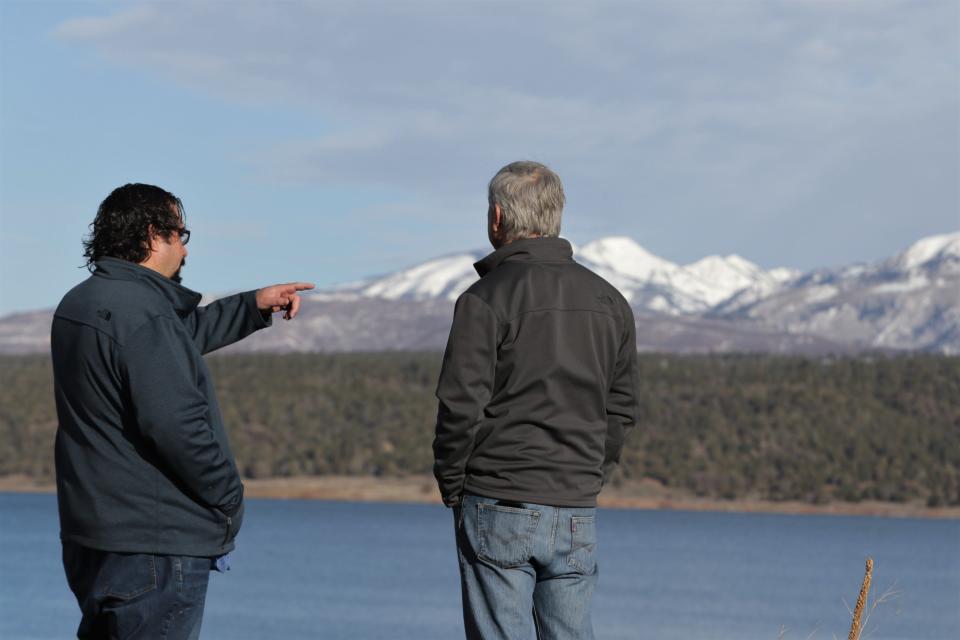Water official says status of local watersheds is better than other areas of Southwest
FARMINGTON — A presentation for San Juan County commissioners on the status of local watersheds on Sept. 6 illustrated that while the Four Corners region remains locked in the grip of a long-running drought, it is in relatively good condition compared to other parts of the Southwest.
The 14-minute presentation delivered by Aaron Chavez, executive director of the San Juan Water Commission, was designed to bring commissioners up to speed on the health of the county's two main watersheds, those associated with the Animas and San Juan rivers.
But Chavez, who is beginning a two-year term as president of the Colorado River Water Users Association, also devoted a significant amount of attention to the status of that watershed, which serves as a crucial water supplier to tens of millions of residents of New Mexico, Colorado, Wyoming, Utah, Arizona, Nevada, California and Mexico.
More:Infusion of government funding could mean good news for San Juan County labor market
Chavez began his presentation by noting that while last winter's snowpack in southwest Colorado was close to normal, it did not yield the kind of runoff one might have expected because the soil moisture content in the region was down substantially after years of substandard precipitation.
"That's why we're not getting big flows," he said.
Nevertheless, most of the indicators Chavez examined this year were an improvement over the recent past, he said, as he noted the Four Corners area has had a good monsoon season this year that has helped make up for the relatively poor spring runoff. Most river basins in the area, he said, are at 90% to 100% of average.
Chavez also presented a slide that showed U.S. Drought Monitor maps of the area for 2020, 2021 and 2022. That visual indicated that the situation in the Four Corners this year is not as dire as it was for those first two years.
"We're still in extreme drought, but we've improved quite a bit," he said. "The map just shows that the drought has moved into Texas and Oklahoma rather than out west."
According to figures from the U.S. Bureau of Reclamation cited by Chavez, Navajo Lake was 55% full as of Aug. 24 — a level that was roughly equal to other local reservoirs, as Vallecito Lake northeast of Durango, Colorado, was at 49% and McPhee Reservoir north of Cortez, Colorado, was at 53%. The good news was that Lake Nighthorse west of Durango was listed at 99% full.
But those figures stood in sharp contrast to the Southwest's two mammoth reservoirs fed by the Colorado River. Lake Powell in Utah and Arizona was only 26% full, while Lake Mead in Nevada and Arizona was at only 28% of capacity.
A slide featured by Chavez explained that the Colorado River basin has been locked in a drought since 2000 and that an imbalance between the management of the water supply and water demand has accelerated the impact of the drought. According to figures supplied by Chavez, 15 million acre-feet of water is being used from the basin each year while the current yield is only 12.5 million acre-feet.
With a crisis having been declared by federal officials earlier this year after water levels at Lake Powell and Lake Mead fell alarmingly in a short period of time, water managers took a number of steps to curb that use, including withholding water for some areas. That did not fix the problem, Chavez said.
More:Cash from state recruitment fund could mean 300 new cops statewide, 30 in San Juan County

"Projections show declines for both reservoirs will continue even with the past and present actions," one of Chavez's slides stated.
Chavez highlighted a statement made by Camille Touton, the Bureau of Reclamation commissioner, during a June 14 U.S. Senate hearing, in which she said between 2 million and 4 million acre-feet of additional conservation is needed just to protect critical levels in the reservoirs in 2023. Touton also noted that it is within the federal government's authority to act unilaterally to protect the system if needed, sending a clear message to water users that they need to do more to reduce their water use.
Chavez said that representatives of the so-called upper basin states that are part of the Colorado River Compact — New Mexico, Colorado, Wyoming and Utah — believe it is the lower-basin states — Nevada, Arizona and California — that should be required to bear the brunt of those reductions in water use, and he said he believes that is exactly what will take place in the near future.
"There is going to be change in the lower-basin states," Chavez said.
To illustrate that point, Chavez referred to a slide that showed projected reductions in water deliveries on the river that are scheduled to take place in 2023, barring a massive increase in upstream precipitation. Arizona is facing a 21% reduction, he said, while Nevada will see its amount of water cut by 8%.
More:Learning from NM mistakes, Forest Service to better heed drought factor before burns
Chavez encouraged all the commissioners to attend the Colorado River Water Users Association annual conference in Las Vegas, Nevada, in December, where he said much work needs to be done.
"We'll be tackling and discussing these big-ticket issues and trying to come up with solutions," he said.
Commissioner Steve Lanier, who also serves as the chairman of the San Juan Water Commission, thanked Chavez for his presentation and described him as a passionate protector of the region's water interests.
"He does a lot of fighting for San Juan County, for the state of New Mexico, actually for some of Colorado," Lanier said. "He fights very hard."
Mike Easterling can be reached at 505-564-4610 or measterling@daily-times.com. Support local journalism with a digital subscription: http://bit.ly/2I6TU0e.
This article originally appeared on Farmington Daily Times: San Juan Water Commission official offers update for County Commission

